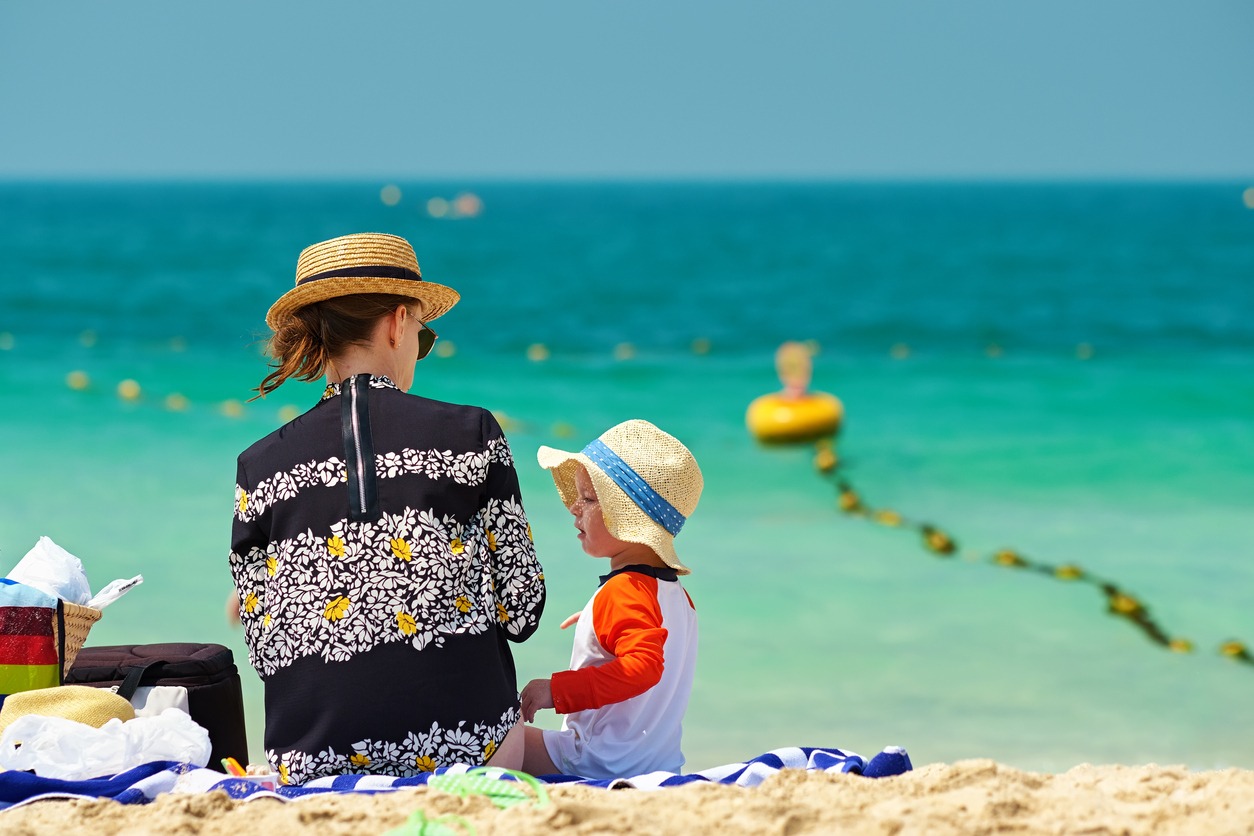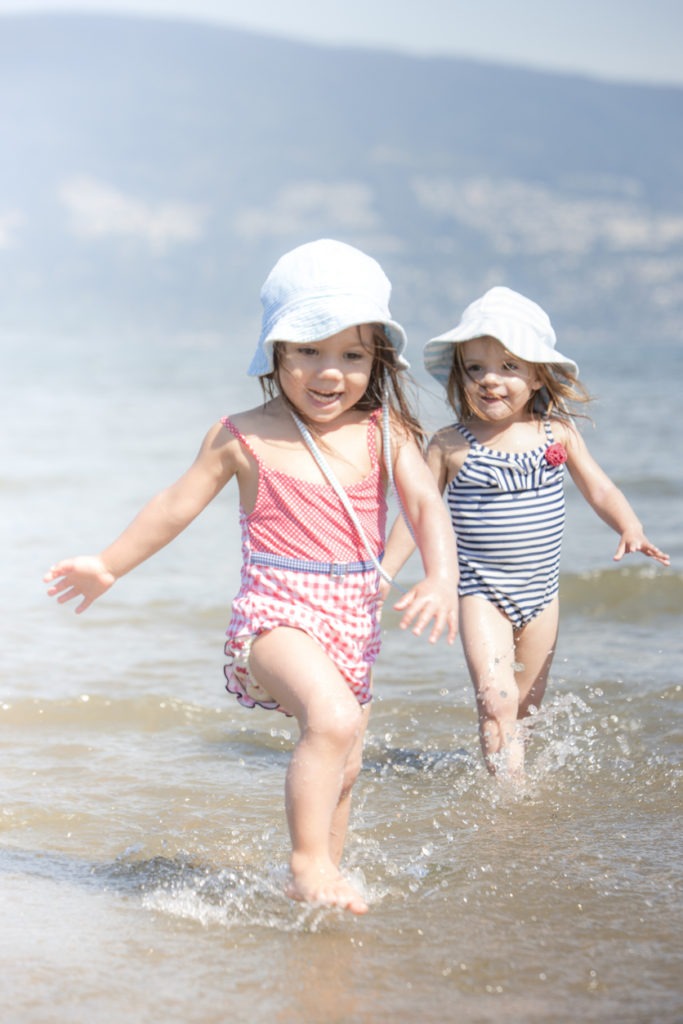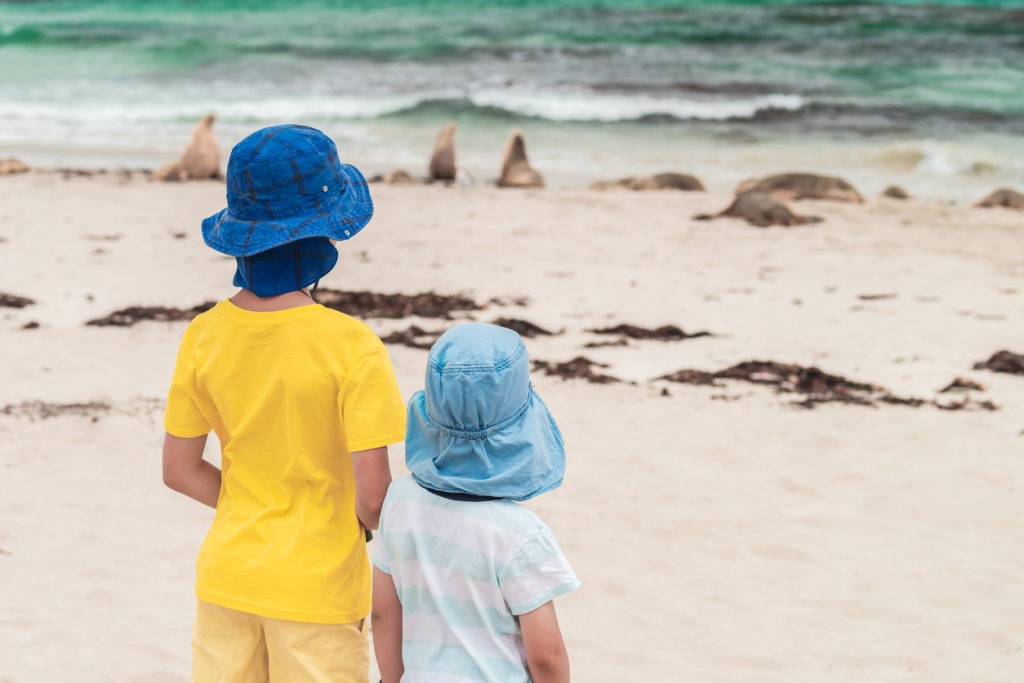Your little one’s skin is sensitive and needs constant protection. So if you are going to go outside with your child during the summer – whether it’s playing in the front yard or spending time at the beach – it’s essential to protect their skin from the sun’s harmful rays. There are many ways to do that: applying sunscreen, wearing sunglasses with UV protection, and of course, wearing a trusty sun hat.
Sun hats are ideal for children as they are light and breathable. A wide-brimmed hat can offer an extra dose of protection for your child and help shade sunburn-prone areas like the face, ears, and the back of the neck. They also provide flexible straps for a secure fit and UV-blocking fabric to protect your child from the sun.
Sun hats come in different colors and designs, so you can choose one that suits your child’s preferences. Once you start shopping for your children’s summer wardrobe essentials, don’t forget to include a sun hat.
When Should Your Kids Start Wearing Sun Hat?
Right away! Using a sun hat right from the start is a good idea. Your baby’s skin is most sensitive and delicate when they are a newborn because their bodies have not yet developed a lot of melanin. Prolonged exposure to sunlight can dehydrate the baby and increase the risk of developing melanoma in the future. So if you’re planning to take the baby outdoors, make sure they wear sun hats.
Is Wearing a Hat Better than Putting Sunscreen?
While wearing a sun hat can offer sun protection for your baby’s head, face, and ears, slathering some sunscreen is still super important, especially if other areas of the body are exposed. Though sun hats can provide shade, it must be noted that your child can still get sunburnt by reflected UV rays.
What Kind of Hat is Best for Sun Protection?
Many modern sun hats are designed to strap under the baby’s chin and fasten with a snap or a drawstring so they will stay put. Make sure to pair a sun hat with a high-factor sunscreen and sun shade, especially for babies less than six months old.
Things to Consider Before Buying a Sun Hat
Not all sun hats are created equally, so if you want to make sure that you get a quality hat that does its job, here are some of the things to consider when shopping for one:
1. UPF rating
Ultraviolet protection factor (UPF) is similar to the sun protection factor (SPF) commonly found in sunblocks. The only difference is that UPF is applied to the cloths instead of lotion. A UPF rating tells you how well a piece of clothing or hat can block UV radiation. UPF-rated fabric is treated to resist the sun and block UV rays to decrease your little one’s skin exposure risk.
All sun hats are designed for UV protection, but there are some hats that are specifically handy to pop on and off when your child is playing in the sun.
If a piece of clothing or hat has 25 UPF, it means that only 1/25th of the sun’s radiation will pass through the fabric and onto the wearer’s skin. The highest UPF factor is 50; therefore, check the UPF rating on the hat, so your child doesn’t get exposed to UV radiation.
Dermatologists recommend a minimum UPF of 30 for those with fair skin. For darker skin tones, a UPF of 20 and not staying out under the sun for too long would be fine.
While you can still buy hats that don’t have UPF ratings, you may not get excellent sun protection. Still, if you don’t have a hat with a UPF rating and your child is about to go under the sun, any hat is better than wearing nothing at all.
2. A back flap
Sunhats with back flaps are preferable as they also protect the back of your kid’s neck from the sun. If your kid has long hair, it won’t be that big of a problem because their hair will protect their neck; but you should probably buy a hat with a back flap if your child’s hair is short.
The neck flaps also cover the ears and onto the side of the neck. They protect the head and ears against the sun’s rays as they are usually one of the body’s most exposed and sun-damaged areas, especially for those with short hair.
3. A wide brim
The hat’s brim must be wide and long enough to provide enough shade for your child’s face. The wider the brim, the more sun your block. It will provide them with extra protection for their head, covering their face and ears along with it. You can choose a brim with a downward slope to give even more sun protection.
The American Academy of Pediatrics (AAP) recommends hats with all-around 3-inch brims to offer ample coverage for the face, neck, and ears.
You may want to consider bucket-style hats with the same lengthy brim all the way around will also provide much-needed extra protection. A trucker-style hat with a large front brim is also a good option.
4. A chin strap
Chin straps are designed to ensure that the hat actually stays on your child’s head. It’s good for babies and an excellent idea for older kids, especially on windy days. You can use a drawstring cord instead for toddlers who get bothered by a tight chin strap against their skin. It will stop the hat from blowing away by the wind.
If you choose a drawstring strap that snugly hugs the chin, make sure it has a breakaway closure to prevent choking and suffocation.
Some toddlers will be bothered by a strap. In this case, don’t try and force the chinstrap on if your child hates it; it will only make them more resistant and frustrated to wearing a hat.
5. Fabric
When choosing a hat, make sure the fabric material is comfortable enough. Is the hat stretchy and breathable? Your toddler and kids have actually to want to wear it; otherwise, they will simply remove it. To better keep out harmful UV rays, choose a tightly woven hat rather than a loosely constructed straw hat.
6. Moisture-wicking barrier
When your kids are outside in the summer, they can become hot and sweaty real fast. Part of this is because of the heat, and part is because they are kids and naturally active.
Since they would be sweating profusely, it would be ideal if the hat had an absorbent headband or sweatband to relieve all of the moisture from their brows. In other words, it should be moisture-resistant even on scorching and sweaty days.
7. Adjustability
Not all kids’ heads are the same shape and size, so look for a hat that is adjustable at the head. This will help keep it usable as your child grows.
8. Breathability
When you’re on the hunt for a newborn sun hat, consider that your newborn may not be a fan of wearing it, so consider something made of soft and breathable materials like cotton to keep their head cool and comfortable.
Pro Tip
If you want to ensure your child is protected from the sun’s harmful rays, keep them indoors between 10 AM to 3 PM each day. It would help if you kept using sun hats until your child grows old enough that they will no longer need you to remind them. While your children are young, teach them about sun safety so they will remember it as they get older.
Small children want to be just like their parents, so to make sure they will wear a hat, wear one yourself. Kids love to imitate their parents, and if you wear hats also, it will make it second nature to them.
There are different colors and patterns to choose from, so when you’re going out to buy a hat, take the kids with you. If they had a choice in what they were going to wear, they are more likely they are actually going to wear it.



